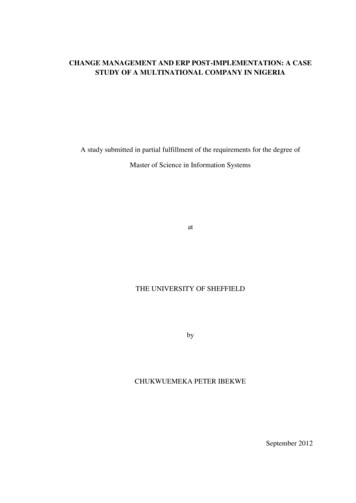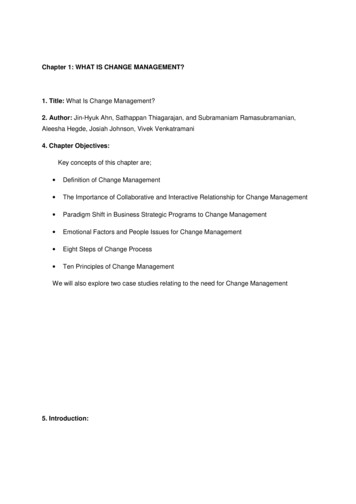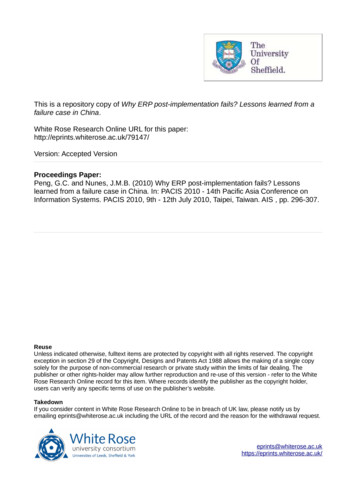
Transcription
Gearing for ChangePost COVID-19The utilities industry is realigningstrategies and E
AbstractStakeholders across the board are chalking out strategies to define and accept thepost–COVID-19 normal. The utilities industry, although not severely impacted, is alsorevisiting its processes and operations to adjust to the situation, especially from a safetyand security point of view.There are two distinct segments in which the utilities industry needs to focus:1. Reactive response to external stakeholders: With a sudden drop in demand and sales,considerable reduction in cash flow, a major jolt in supply chain activities, and morestringent guidance from regulators, utilities must create alternate roadmaps andmechanisms to ensure that the top and bottom lines are healthy in tandem withcustomer satisfaction.2. Proactive mandate for internal stakeholders: With mandatory social distancing,isolation, and fear of the pandemic, plant and field operations require to be redefinedwith additional safety.This white paper analyzes both the segments and suggests approaches to respond tothese stakeholders.PURPOSE-DRIVENRESILIENTADAPTABLE
Renovation in Progress: How will the Utilities Industry Change?With COVID-19, the utilities industry is slated towitness some short-term and other permanentreverberations down the line. As an immediatereaction, we noticed delays in capital projects,scrapping of planned activities, reduction in ITspends, and more stringency in rate case approvals.Along with that, regulators and governmentsacross the world imposed guidelines favoring theend consumers – from no action to be taken fornon-payment to lowering the slab rates for billing.From a long-term perspective, there will be a largerstrategic shift for utilities in moving from aregulated to a deregulated regime. What theseperspectives bring to the fore is that, now is thetime for utilities to assess their existing systems,identify problem areas, and create room forevolution. Propped by the adoption of digitaltechnologies, this restructuring could bring abouta revolution in utilities. Before examining the scopeof enhancement, let us explore some of the effectscaused by the pandemic.
Impact on the Major PillarsSupplyAs a knee-jerk reaction to the pandemic, generation andtransmission have to be adjusted to the new normal with aminimum of 5-15% decrease in demand. Production for thebaseloads is being reduced as per the following order –nuclear, wind and solar, coal-fired, gas-fired, and hydro – tomanage medium to peak loads.Distribution has eased due to demand reduction, making iteasier and faster for firms to integrate small-scale domesticrenewables with the low/medium voltage side. This will bepossible only if the supply chain of materials is operatingsmoothly.In the long-term, the generation, transmission, anddistribution of power due to the effects of the pandemic willchange, as follows: For logistical reasons like reduced transportation facilitiesand scarcity of human labor (mostly in India), theproduction and supply of coal will drop under COVID-19circumstances, and hence, there will be a noticeable shiftfrom coal-fired generation to others. A dip of 30% in gas prices between December 2019 andMarch 2020 will increase plant load factors ofgas-powered stations. Forecast mechanisms for generation and transmissionwill require a complete change of algorithms – ‘last yearthis month’ will be replaced by ‘last three months or lastweek/month’. Besides, weather and other externalconditions are other factors to be considered. Unorthodox suppliers like battery reserves, microgrids,and vehicle-to-grid (V2G) will gradually pick upmomentum, as consumers start favoring reliabilitythrough alternate means.[1] CNBC; Energy demand, hit by coronavirus crisis, is set to see record drop this year, IEA says; April 30, onavirus-pandemic-iea-says.html[2] Congressional Research Service; COVID-19: Potential Impacts on the Electric Power Sector; June 12, 2020; 1300[3] US Energy Information Administration; Natural Gas; https://www.eia.gov/dnav/ng/ng pri sum dcu nus m.htm
DemandAs an immediate reaction to the pandemic, the overall demand for power will witness a sharp drop, with industries andcommercial establishments going into a slumber. While domestic demand has increased only marginally by 3-5%, stringentguidelines from most utilities to not pressurize consumers to pay has resulted in a dip in cash flow.The long-term changes to demand are envisaged as below: The load curve will flatten out considerably with lesser peaks and troughs, while consumers adjust to the new normal ofworking from home, staying in isolation, etc. Meanwhile, demand during weekdays and holidays will be similar. Of the increased availability and use of renewable rooftop solar installations or wind turbines, consumers will lean towardshomegrown power generation. Simultaneously, localized grids with the right mix (battery storage and renewables) will gainwider adoption. Technologies like blockchain, which are already available, will facilitate the growth of community microgrids.[4] BBC News; Coronavirus: Domestic electricity use up during day as nation works from home; April 18, 2020; https://www.bbc.com/news/technology-52331534
Operational Changes Envisaged in UtilitiesIn order to align with the recent market volatility and streamline the sector, utilities need to revisit theiroperations. Some changes that we envisage in the respective areas of operations are given below:Field Operations Utilities will substantially move to contractor-based field support, whileemployees will only be deployed to support niche areas. Learning andknowledge transfer will be conducted remotely through technologies likeaugmented and virtual reality, artificial intelligence, and machine learning. Field operations will be monitored more stringently and in real-time, withdata flow becoming ubiquitous, be it asset, workforce, operator, orthird-party related. People working as drone operators, metering and communicationcommand center operators, image annotators, and AI-ML and AR-VRdevelopers will be much sought-after by utility firms.System Control Control and command centers will be more than just outage anddistribution management systems. Support for advanced meteringinfrastructure (AMI), integration with third-party data sets (like the weather),asset performance management, and geographic information system (GIS)heat maps will have to be considered to ensure a resilient grid. The shifts will be of shorter durations and rotational for key workforce safety,where employees will be given access to operate from laptops, mobilephones, and tablets irrespective of location.
Revenue With provisional billing conducted due to meters going unread manually, automated meter reading (AMR)/AMI withhuman-in-the-loop billing support systems will be required by utilities. To handle the aftermath of provisional billing – which inadvertently increases billing complaints – self-served automatedcorrections will be brought in. For the drop in revenue collection, incentivization will be introduced along with additional pay channels, bycollaborating with other industries and taking advantage of such external resources.Consumer Touchpoints Virtual offices (call centers) and self-servicealong with omnichannel experiences will bemore sought after with extended hours andshifts, to increase support and customersatisfaction.A single centralized virtual back officesupported by bots can be created. Bots andchat responses will be more effective thancall-in services for utilities.Corporate Operations Materials and asset procurement guidelines willbe reworked upon. Inevitable condition-basedmaintenance will be the guiding factor to planfor procurement. Secure Borderless WorkspacesTM inutilities-specific scenarios and the subsequentorganizational change managementframeworks will help utility firms transition theirworkforce to remote working operations.
IT-OT Use caseWithout doubt, information technology (IT) and operational technology (OT)will be major game changers for the utilities sector under the present scenario.Though many capital projects in IT are delayed, put on hold, or even scrapped,we see a surge in the requirement of alternative projects in collaboration,remote monitoring, communication system enhancements, and analytics. Someof the trends that are expected to pick up where IT-OT can play a huge role areas follows:Smart Meters and Integrated Distribution Management SystemsFor utilities yet to be on the AMI roadmap, the immediate ask will be from consulting toroadmap creation, while maintaining a phased implementation approach, as much as therate case permits. There will be an added thrust to safeguard existing investments andutilize the same for newer apps. For example, investments done in AMR and outagemanagement systems (OMS) will need to be protected by add-on applications to gaininsights from conflated data sets – especially where new funding for major capex is puton hold. Given these developments, smaller but effective value propositions on remoteoperations and palmtop analytics for decision making will get a significant boost.
Smart Control RoomsDrone and Smart Machine-Based InspectionsActions like remote readings,disconnections-reconnections, demand response,alert-event handling, communicationmanagement, etc. will be controlled throughnew-age command centers.Unstructured data sets from multiple sources likesatellites and drones and structured data sets likeasset management, GIS, and workforcemanagement will be required in field monitoring.Automation tools will ingest these data sets andsubsequently process them.More Robust and High-VolumeCommunication NetworksSecurity Reinforcement – Physical, Network,Data, and Remote Devices AccessibilityCommunication will be key to remote operations,and as a result, there will be a huge demand todevelop, modify, improve, and maintaincommunication infrastructure – machine tomachine, machine to human (vice versa), andhuman to human.As remote operations get extended beyond acompany’s firewalls, utility firms will need tooverhaul their cybersecurity set up. Multi-factorauthentication, image recognition, and analyticswill be in huge demand. An additional componentof technology intervention will be to ensure socialdistancing in plants through internet of thingswearables, safety gears, and masks.
ConclusionDuring this period of uncertainty, the only way forward for utilities is to embrace risks and respond in a moreagile fashion. TCS’ Business 4.0TM value drivers emphasize on the importance of building a robust digitaltechnology foundation to pursue favorable economic behaviors. While these long-term trends continue todrive utilities towards growth, transformation, and sustainability, we believe that, in the interim, enterprisesneed to focus on ensuring resilience and adaptability during these difficult times.About the AuthorAnupam ChakrabortyAnupam Chakraborty is an Industry Advisor and a Domain Consultant in the Utilities Business Unit at TataConsultancy Services. In his capacity as an advisor, he leads the grid modernization and strategic initiativesof machine vision in the Utilities Business Unit. Anupam has nearly 26 years of operational, management,and consultancy experience spanning IT and electricity utility environment, electricity distribution,transmission, generation (including renewables and alternate sources), customer relationship management,commercial and financial functionalities and business enterprise development. He has worked in multipleUSAID projects and smart initiatives in his earlier assignments.
ContactFor more information on TCS’ Utilities solutions and services,please visit l: utilities.marketing@tcs.comAbout Tata Consultancy Services Ltd (TCS)Tata Consultancy Services is an IT services, consulting and businesssolutions organization that delivers real results to global business,ensuring a level of certainty no other firm can match.Corporate Marketing Design Services M 08 20TCS offers a consulting-led, integrated portfolio of IT and IT-enabledinfrastructure, engineering and assurance services. This is deliveredthrough its unique Global Network Delivery ModelTM, recognized asthe benchmark of excellence in software development. A part ofthe Tata Group, India’s largest industrial conglomerate, TCS has aglobal footprint and is listed on the National Stock Exchange andBombay Stock Exchange in India.For more information, visit us at www.tcs.comAll content / information present here is the exclusive property of Tata Consultancy Services Limited (TCS). The content / information contained here is correctat the time of publishing. No material from here may be copied, modified, reproduced, republished, uploaded, transmitted, posted or distributed in any formwithout prior written permission from TCS. Unauthorized use of the content / information appearing here may violate copyright, trademark and otherapplicable laws, and could result in criminal or civil penalties.Copyright 2020 Tata Consultancy Services LimitedPURPOSE-DRIVENRESILIENTADAPTABLE
company’s firewalls, utility firms will need to overhaul their cybersecurity set up. Multi-factor authentication, image recognition, and analytics will be in huge demand. An additional component of technology intervention will be to ensure social distancing in plants throu











